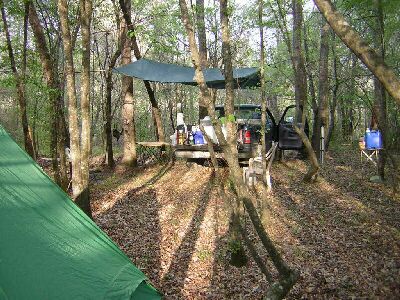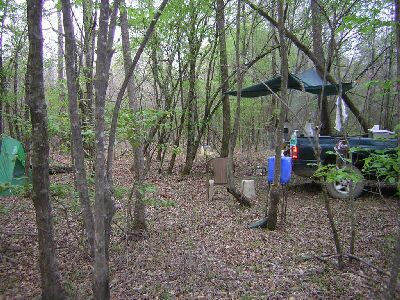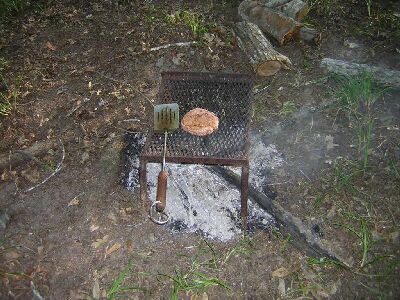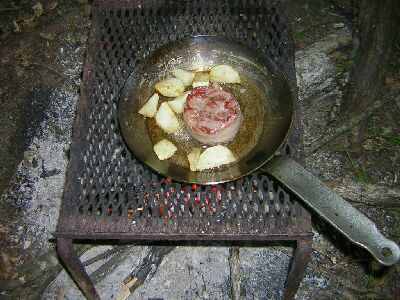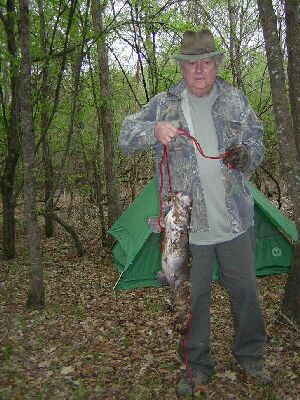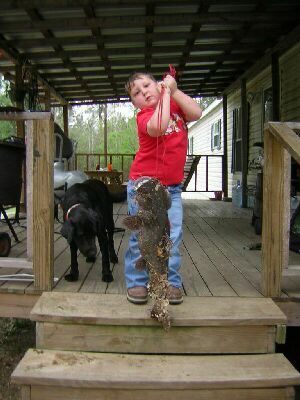(Here we go again!)
Copyright 2011 by Junior Doughty
|
I have loved camping since I was a child. In the spring of almost every year, my family and extended family loaded camping equipment in the back of pickups, and we'd spend weekends on the bank of a creek. We'd catch bream by the hundreds and fry them in big cast iron pots over the campfire and over homemade propane burners. Best I can remember we never owned a tent. That was in circa 1950, so our shelters were WW II canvas tarps hung between trees, and our beds were WW II army cots. I have no memory of how we dealt with mosquitoes. Probably with what we called "skeeter bars," i.e., mosquito netting, and with a repellant in an Olive Drab can with a government part number on it. Nowadays, circa 2011, my camping equipment comes mostly from three sources: Cabelas, Campmor, and Sportsmans Guide. I frequently daydream about camping, and I find myself spending daydream hours on the web sites of those three companies. That frequently results in finding camping equipment I can't live without. That always results in plenty of catalogs in the mail. I get lots of bathroom reading material.
For those wanting to fish and hunt along Little River:
There are two primitive campgrounds in the LRWMA. One sits on high ground and is available year round. The other one sits on low ground and is closed during times of high water. Those campgrounds are full on opening weekends and vacant or nearly so on other weekends. If you like cold weather hunting and camping, as I do, you can basically have 4,164 acres all to yourself. At the low-ground campground, you can pitch your tent just a few feet from the river. Both campgrounds contain numerous large oaks, so there's shade aplenty. The low-ground campground is one of my favorite camping spots. You can fish in either the aptly named Fish Creek or in Little River. Throw some catfish lines in the river beside your tent and walk about 100 yards with your cane pole and catch bream in the creek. You'll need a $15 WMA Hunting Permit in addition to normal licenses. You can only stay two weeks at a time. Bring a bucket for human waste and use it. Places such as Cabela's sell a commode seat (# JB-514868) which fits nicely on top of a 5-gallon bucket. If you have steel butt cheeks, just sit on the rim. As I both pictured and described fully in my May — September 2009 article, Five Part Camping Trip, high water is a big worry at my private campsites along Little River. At a river level approaching 15 feet I take a risk of getting my vehicle stranded by backwater across low-water bridges. I've seen the river rise 10 feet overnight, so a 15 feet Internet gauge level is my Don't Go Camping mark. Another problem I experienced with this March 2011 camping trip was drought conditions marked by a burn ban. I couldn't build a campfire, and as far as I'm concerned a campfire is a camping must. I don't know which I like best—camping or campfire cooking. And so as the days of March, 2011, X-ed off my calendar, I waited for a rain. Finally near the end of the month it came, and the burn ban lifted. During hunting season I had found a campsite with much easier access to the river for my arthritic knees and ankles than the campsite of September 2009, which was about 1/2 mile downstream. A hog/deer/coyote path snaked down the sloping bank like a tiny Lombard Street in San Francisco. My arthritic joints made it down to the river and back up the bank with minimum pain. The woods around the new campsite on the river's natural levee contained almost no firewood, so I loaded my truck with chunks of left-over winter stove wood and headed for Catfish Camp 2011. I also took my Timberline 4 tent, my Guide Gear Cumulus Shelter, and my campfire cooking equipment, i.e., the grill, the bean rope, and my pots and iron skillets. The plan was to spend the afternoon leisurely setting up camp and to return the next day and actually camp. I also had concerns about my 2-wheel-drive truck and ~2 miles of dirt roads more like muddy ATV paths than roads. So the main purpose of the pre-trip was a road check.
Wednesday: Day #1The welcome rain had filled the holes in the dirt road with water, and high winds had blocked the road with deadfalls. Good rear mud-grip tires carried my truck through the holes, and a tow strap attached to the truck's front bumper pulled the deadfalls aside. It took over an hour to drive 2 miles, but I finally backed the truck into the new campsite and began setting up camp.It had rained, but I raked a large area around the campfire location. The ground was ankle deep in dead leaves which were damp on bottom but dry on top. No burn ban was in effect, but unless it rained again I would have to build only a small campfire during windy daylight hours. That sucked big time, but small was better than none. I continued working. An hour into my camp work, I noticed movement a few yards away in a tree. I looked up just in time to see a large, reddish-brown hawk fold its wings as it assumed a perch on a limb. I'd never seen a hawk so large. It looked a lot like my momma's big red rooster from many, many years earlier. It was no more than 30 yards away and sitting there looking at me. I said, "Howdy, Mr Hawk. Checkin' me out?" As it sat there seemingly unafraid of me, I stepped to my truck and removed my binoculars from the backpack on the seat. I raised them for a much better look at Mr Hawk. Off he flew, landing in a large oak some 100 yards away. I studied him from a distance for a few seconds, then he flew and disappeared. I put my binoculars in the backpack and started erecting my Guide Gear Cumulus Shelter, actually a heavy duty, multi-grommeted tarp I like so much I will probably cry when it finally wears out. Thirty minutes or more later I had the tarp tied off with bungee cords hooked to trees and had it erected over the rear end of my truck bed. Now, if it rained, which I hoped it would, I could sit under the tarp and watch the campfire and relax with a cold Pabst Blue Ribbon beer. I noticed movement again. I looked up, and the hawk landed on the same limb. It sat there and looked at me again. Obviously, it was wondering about the commotion and the stranger in its woods.
I had seen that behavior in birds before—years ago when I varmint hunted with a 22-250 rifle. I could park my truck 200 yards from a flock of crows, and they would sit there as long as I did. But the second I stuck a rifle barrel out the window, off flew the crows. It happened many times. I finished erecting camp, and while I worked I kept an eye out for the hawk. It didn't return. Late that afternoon, I left camp and came home. At home, I searched the Internet for Mr Hawk. And there it was, plain as day—Mrs Hawk, a female Red-tailed hawk. As it was spring, her much smaller mate was probably at their nest, which I suspected was a commandeered squirrel nest in one of the oak trees around my campsite. Well, I was plum tickled. I might could find the nest and spend my spare camping time watching baby hawks. Life was good!
Thursday: Day #2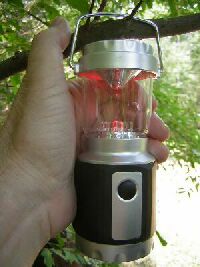 I headed back to camp a little after noon the next day. I stopped about 125 yards from camp, and on a limb beside the dirt road I hung this little safety device I call a "Night Hunter Warning Light." The red LED blink, blink, blinks all night long.
I headed back to camp a little after noon the next day. I stopped about 125 yards from camp, and on a limb beside the dirt road I hung this little safety device I call a "Night Hunter Warning Light." The red LED blink, blink, blinks all night long. I carefully found a spot to hang it where a night hunter would both see it and simultaneously see a spot to turn around. No night hunter would drive down a dirt road through the woods if he saw a red light blinking up ahead. He'd holler, "Holy s**t! Cops!" Then he'd do a fast turn around in the nearest suitable spot. The same goes for amorous couples, and there's lots more of them than night hunters. This little $5 light has saved me from many unwelcome late night visitors. This little beer can-sized light cost $5 at Wal-Mart several years ago. It's still on its original AA batteries, and I leave the red LED on 24/7 while I'm camping. I bought another one because I liked the first one so much. I use one as a warning light and the other one as a camp night light on the tailgate of my truck. The little push button has 3 settings: 1 blinking red LED; 3 solid-burn white LEDs; and 6 solid-burn white LEDs. Get yourself one or two! The truck parked in camp, I got out and looked around for Mrs Hawk. Nothing. The truck contained mainly my sleeping gear for the already-erected tent, the drink ice chest, the food ice chest, and both of my big gray Rubbermaid® storage boxes—again with dry & canned food in one and cooking/camp utensils in the other one. The sleeping gear I put inside the tent consisted of:
NOTES:
My arthritic knees hurt like crazy while I was putting stuff inside the tent and while I was crawling in and out of the tent. That didn't bode well for happy camping. Nineteen months had passed since I last crawled inside the Timberline 4 tent. It hurt my knees then, but now the pain approached the agony level. Obviously, my arthritis had worsened. I spent the early afternoon busy around camp, mainly gathering firewood. The oak chunks I brought from home would make a much larger fire than I trusted while surrounded by a thousand acres of dry leaves. The little 5-star Camp Chef D05 Dutch Oven 3/4 Qt I had packed for baking biscuits, beer bread and cornbread would stay packed on this trip unless it rained. I gathered mostly thumb- to wrist-sized deadfall limbs of an unknown species, knowing only that the dead limbs weren't pine. As my momma would say, Cookin' with pine gives food a "whang." An interesting event happened circa 3 pm, Thursday: Day #2. I was relaxing in my plastic chair and sipping a glass of ice water. I would occasionally look around and search for Mrs Hawk and admire the awesome beauty of the deep woods river bottom around me. In a peaceful moment of deep relaxation, I suddenly craved a cigarette. It dumbfounded me. I hadn't craved nicotine in years. I hadn't smoked a cigarette in exactly 13 years and 8 months. At circa 4 pm I gathered my box of nightcrawlers, my 8 pre-made set lines, a roll of yellow surveyor tape to mark the lines, and I headed down Lombard Street to the river. The riverbank was almost covered with animal tracks. Those I recognized included deer, hog, coyote and coon. The hog tracks were huge and all probably from the same hog. I estimated its weigh at 100 to 150 lbs—probably a solitary boar. I could see where deer and the hog had stepped to the edge of the river for a drink, and then turned and walked away. A jumble of tracks lined the edge of the river, and tracks of solitary animals meandered in little trails all over the slope of the bank. Below, we see the river and 5 of the set lines marked by yellow tape. The other 3 are off to the left. A reader might wonder, Why only 8 lines?
But, mainly, I didn't want to clean more than 1 or 2 catfish, and that's what I expected to catch on only 8 lines. Note the 2 cypress knees at the bottom center of the photo and sticking up about 6". Note more cypress knees about 2' to the left. Note in particular the space between. That's where my back landed about 30 seconds after I took the photo. I had taken this photo of the yellow flags and of both river banks. Then I stepped forward to just past the cypress knees in order, I guess, to double-check the lines and admire the river. A sudden severe arthritis pain in my left knee made me unconsciously shift weight to my right knee, and the shift sent both feet slipping down the river bank like shoes on greased glass. With a loud whump my butt and my back hit the ground between the cypress knees. I lay there for at least a minute catching my breath and my senses and letting the pain subside. I had barely missed ramming a cypress knee into my back somewhere between the L1 and L5 vertebrae. Gingerly, to say the least, I got to my feet. The horror of a broken back in such a remote location struck me. I could have crawled to the river for water, probably, but no way could I have crawled up the near-vertical river bank to camp . . . and to my cell phone, which, like a fool, I had left plugged in the charger inside the truck because it seldom worked down by the river. No, I would have had to stay there beside the river and its lifesaving water and wait for maybe days for rescue in the form of a rare boat going up or down the river. Or rescue in the form of somebody wondering why buzzards were circling. My cheerful outlook much diminished by the near disaster on the river bank, I cautiously climbed Lombard Street to camp. The wind had lessened, so I built a small campfire, not for cooking but for contentment. I was in no mood for cooking. I eased into my plastic camp chair. After a while the soreness in my back subsided. I finally relaxed again. Around 6 pm I looked up from the campfire. There about 50 yards away on a high limb, I could see Mrs Hawk. In my worry about the near disaster beside the river, I'd forgotten about her. So I watched her while she sat on the limb and watched me. I got up and rummaged around in the truck, and she sat there. I sat down, and she still sat there. A few minutes later I got up and stirred the fire, and when I looked up again she was gone. By then, I knew I was having a really cool experience with Mrs Hawk. My appetite had returned, so I supped on Vienna sausage, cheese and Wal-Mart French bread chased down with dry red wine from a 5 liter cardboard box. I kept just enough wood on the campfire to generate a small flame and a wafting plume of smoke. As darkness approached and the wind died, I added a stick to the fire and poked the unburned ends of other sticks toward the flames. As I peacefully watched the flames grow brighter as the night grew darker, all around me was silence. I missed the birds at my campsite beside the oxbow lake a mile away. There at the cracks of dawn and dusk, hundreds of birds all said good night or good morning to each other in high-pitched and low-pitched songs in every loudness level possible for birds. Here beside the deep-water river, the crack of dusk had closed in silence. And a rifle fired. The sound came from a guessed 1/2 to 3/4 mile distance. A few seconds later, the rifle fired again. From the sound, I guessed a night hunter with a 22 magnum rifle. From the direction of the sound, which the second shot had allowed me to accurately course, I guessed the location as a pipeline crossing on the gravel oilfield road leading to the river bottom.
The headlights of a vehicle traveling a mud hole-filled road at night raise and lower their beams as the truck raises and lowers as it goes in and out of the mud holes. From a long distance, you can watch the tops of tall trees become softly illuminated and then go dark, over and over. Like traveling a huge U the night hunter would have to take a ~3/4 mile gravel/dirt road, turn right on a ~3/4 mile dirt/mud road until it met the river, then come toward me on a ~3/4 mile very narrow dirt/mud road along the river. The motor in his truck would strain noisily through dozens of mud holes on its way to me. Had I seen the shine of his headlights on the trees above the dirt road or the flash of his spotlight through the woods or the sound of his straining motor coming toward me, my plan was simple: I would pick up the SKS and step into the woods and become a statue. As I wore dark clothes, he would see me only if I moved. Night hunting is a problem in rural areas like where I live and where I camp. My uncle once lost a Black Angus calf to a night hunter who shot the calf between the eyes with a 22 and left the calf to rot. I lost two pigs to a night hunter. I once found a doe shot between the eyes and with both hams removed. On the very road I write about here, the road once told me a night hunter tale. On a dawn hike down the road, I found fresh truck tire tracks which stopped before crossing a mud hole. Some twenty-eight of my steps down the road past the mud hole, scraped ground and deer tracks marked where a deer wheeled and fled. Two steps past the scraped ground, a spray of blood and gore on the ground marked the effects of a rifle bullet exiting the same deer's body. Every two or three steps down the road, deer tracks and drops of blood marked where the running deer's feet hit the ground and where blood spurted out of the deer. At circa fifty steps the tracks stopped and a pool of coagulated blood marked where the deer fell and died. Retracing my path back to the mud hole, I saw my own tracks and the to-and-fro tracks of two men. I read the story as follows: I estimated the time of the crime as maybe 3 to 4 am, some three hours earlier than the time I stood there. Two night hunters in a truck saw a deer in the headlights. One of them, most likely the passenger, stuck a rifle barrel out of his window and shot the deer. The deer ran but quickly hit the ground and died, still in the headlights. The two men jumped out of the truck, ran to the deer, picked it up, then ran back to the truck and dumped the dead animal in the truck's rear. No more than 90 seconds would have passed. Down the same road and alone in camp, now, I worried about the night hunter or hunters I had heard shoot. If my blinking red light stopped for some reason and the man or men came driving up, who knows how they would react to being caught? Several long minutes passed. I heard nothing and saw nothing. At circa 9 pm and in pitch black night, I returned the SKS to its rack and soon crawled inside the Timberline 4 tent. It was agony getting inside it. But the thick sleeping bag atop the even thicker sleeping pad was softer than my bed at home. When the knee pain lessened, I slept like the proverbial log, all warm and cozy in the 50° night. At exactly 1:30 am, a barking dog woke me. I guessed its location as down the road near my warning light. It probably didn't expect a blinking red light in its woods. I found the flashlight and unzipped the tent door. In an effort to stop the noise, I shined the flashlight toward the noise and yelled, "Hey! Shut up, you stupid son-of-a-bitch!" The barking stopped after my polite warning, so I crawled back inside the sleeping bag. As the knee pain lessened again, I became all warm and cozy again. I woke long after the sun came up.
Friday: Day #3As coffee water boiled on the truck tailgate I built up the fire for breakfast. As I sipped the world's best coffee I searched the woods for Mrs Hawk. She was probably laying an egg or hunting breakfast because she didn't show the entire morning.Below is a look westward at Catfish Camp 2011 that very Friday morning at 8:25 am.
The chair is in the watching-the-fire position. Go left straight across from the chair to the shiny double-tree. In the full-size photo at the very right edge of the double-tree you can barely see my grill, a tiny fire, and a Jimmy Dean Sausage Egg Cheese and Biscuit wrapped in foil and getting heated for breakfast. Up slightly and to the right of the grill, the round black objects are hanging skillets. A tad more to the right is my fold-up table with nothing on it. Far to the right edge of the photo, the blue thing is my 7-gallon water can—written about here. The fold-up Coleman rack on which it sits was a waste of $15. While breakfast was heating, I went down Lombard Street and checked my lines—8 bare hooks. Oh, well, I still had at least 4 days of fishing and camping ahead—if my knees held up and I didn't fall down again. I had an ominous experience at the river's edge. I was double and even triple careful while standing and walking on the slick bank beside my lines. And I almost fell again. To my delight, my shoe skid marks and my butt/back mud depression all contained deer and hog tracks put there during the night. Below is a look southward, downriver, at Catfish Camp 2011.
If you missed the cooking instructions in my previous article here's how: start with an ice-chest-thawed Jimmy Dean 1-pack Sausage Egg Cheese & Biscuit or a 2-pack of the smaller Jimmy Dean Sausage & Biscuit. Remove the plastic wrapper and discard it. Wrap the biscuit(s) in foil and place it beside the campfire flames, not over the flames. You don't need heavy-duty foil. If all you have is coals, place the biscuit(s) beside the coals. Turn once per minute. Swap ends, too. Check for doneness after 5 minutes. YRMV, but I like mine crisp and slightly charred on both sides. You can campfire cook other brands of pre-packaged sausage & biscuits using the above method, but take my word for it—Jimmy Dean brand is the best tasting. I promise—cheaper won't be as good. Look above the left shoulder of my chair and see a hanging table made from a piece of plywood. It contains 3 jugs of cooking oil, one full of fish cooking oil, one full of plain ol' cooking oil, and a spare full of new oil. For all cooking, I use good-brand vegetable oil such as Crisco®, Wesson® or LouAna® mainly because it's made in Louisiana. For fish, I prefer damn-the-cholesterol lard, but I save my home-rendered, non-additive stash for making this bullet lube. Look above my truck's right rear tire at my plastic bottle sink station and the white, old sox hand towel above it. The observant will see a toothbrush and a red & white tube of toothpaste attached to the bottle. Looking like it's sitting on my truck's tail light, the blue/green thing is a hanging bottle of liquid hand-wash soap. The above photo also shows (1) the position of the Guide Gear tarp in relation to (2) the position of the rear of my truck and (3) the location of the campfire—which is always under a limb or leaning tree from which I can hang my bean rope. In rain, I can sit under the tarp and make coffee or cook on the tailgate of the truck, and I can do the same on the campfire. The tent also has to be located nearby on level, stob-free ground and under live trees with no dead limbs. All the above is why it's difficult for me to find a proper campsite. Such a spot with Lombard Street access to the river is even harder to find. In fact, this is the only such spot on 3+ miles of river frontage. The rest of Day #3 was free except for baiting my catfish lives before dark. I spent most of the day meandering around the woods with the backpack on my back, the SKS over my shoulder or in my hands, and the binoculars around my neck. The SKS served as both bad guy and hog medicine. I hoped to see a young pig, but, alas, I saw only pig tracks—in sizes from tiny to extra large. With the binoculars, I checked out every squirrel nest I came across for sign of a nesting hawk. Nothing. I checked some of the bottomland archaeological sites for new looter damage. All ok. On the way back to camp, I checked out even more squirrel nests. Still nothing. In hindsight, I suspect Mrs Hawk saw me looking through the binoculars and also saw the rifle I carried. I saw her not even once that entire day, Friday: Day #3.
Notice the raked-bare ground. Notice the tiny fire. Notice the chunks of oak stove wood sitting unused due to the wildfire hazard. What you can't notice is the taste of the patty after it was grilled. Whang perfectly describes the way it tasted. Yuck also describes it. Whatever the species of my firewood sticks, it wasn't suitable for grilling. I pitched the patty down the river bank for the coons and dined on a bologna sandwich. My beloved campfire cooking wasn't turning out well on this trip.
Saturday: Day #4Again, I slept the sleep of those pure of mind and those with soft and warm bedding on a cold night. Nothing bothered me all night long. Well, it bothered my knees something awful when I used the chamberpot. I barely had headroom to kneel inside the Timberline 4 tent. The alternative was to unzip the door and let mosquitoes inside the tent, then crawl outside in my underwear and let the mosquitoes feast on my bare legs while I stood and peed. No thanks. I got on my knees in the tent and endured agony while I peed in the chamberpot. The simple act of getting out of the ground-level sleeping bag wasn't easy and pain free either.Sadly, I faced the reality of replacing my beloved Timberline 4 tent with one in which I could stand and in which I could put a cot. It also meant facing the reality of my age and health—68 and going downhill. Morning came, and I went through the same routine—boiling coffee water while I built up the campfire for breakfast. How can a man possibly spend a better Saturday morning than sipping coffee while watching a campfire in the deep woods? Waking up on a feather mattress beside Julia Roberts? That'd work! So far in 4 days I had seen or heard no sign of other humans except for the night hunter's shots. During winter when the deep woods oaks are bare, at camp I can hear the trains roll through the Georgetown crossing several miles away, their whistles sounding far off and lonesome. In spring and summer, I can't even hear the train whistles. A trip down Lombard Street to the river bank produced 8 bare hooks again. Oh, well, no catfish caught means no catfish to clean. Another lazy day passed. I spent more time with the SKS looking for a small hog, and I spent more time with the binoculars looking for Mrs Hawk. She'd moved, I guessed. About 4 pm that day, Saturday, I went down to the river and baited my hooks. I heard a hawk's shrill cry from upriver somewhere. Maybe she hadn't moved, I hoped. Back at camp, the wind died at 6 pm, so I built up the fire for dinner, supper to us rednecks. By golly, I planned to cook a steak! At exactly 6:36 pm according to my notes, a boat put put puted down the river. I didn't bother walking a few yards to see who it was. I just listened to the boat put put downstream and thanked God I wasn't on the riverbank covered in 50 hours of mosquito bites and screaming, Help! Help! Help! I popped the top on a Pabst Blue Ribbon and toasted my own good fortune. At that moment I saw Mrs Hawk. She was gliding a downward sloping path toward a small pool of water about 50 yards behind the Timberline 4 tent. She had been sitting on her original limb and watching me, I believed. Now, I watched her glide silently to the edge of the water and grab something, then flap her huge wings and slowly gain altitude, flying away with what looked like a small snake writhing in her talons. I had seen such a thing on TV, and now I had seen it in reality. As I watched, amazed, she disappeared into some huge oaks 200 yards off in the woods. Good fortune had many forms, I suddenly realized.
There's a big write-up on these wonderful Bourgeat 5-star campfire cooking pans near the end of my previous camping article. It includes ordering info. Here it's cooking steak and taters over whang wood the night of Day #4. This is a bacon wrapped fillet sold in heavy shrink-wrap at my local supermarket in a 2-for-$5 package. If I hadn't known about whang wood I would have ruined this great little steak by cooking it over whang wood coals. I simply added a little oil to the pan, dropped in the steak, sectioned a tater and dropped it in, then grilled it. Slightly past the level of doneness you see here, I added a sectioned onion. I didn't even dirty a plate to eat this. I poured off the oil, then put the hot pan on a rag on top of my flotsam end table. I ate it with leftover Wal-Mart French bread and chased it down with cardboard box dry red wine in a styro cup. It was slap yo' momma good! Darkness found this wine-head scribe with a full belly and a feeling of rare contentment. In normal wet weather, I would have built a big fire and watched it slowly burn down to coals, shimmering in the blackness of night. When my small fire died away, I crawled inside the tent. I don't remember if it hurt or not.
Sunday: Day #4But I do remember exactly what happened at exactly 3:30 am the next morning.I had slept in my pants for some reason. The wine, maybe? I was on my knees urinating in my chamberpot. My knees hurt like the hounds of hell were chewing on them. Suddenly my left leg cramped. I began crying out in pain. I moved my left leg to ease the double pain from the cramp and the arthritis. The pains hurt worse. Now with more weight on my right knee, it hurt worse. I cried out even louder. I suddenly felt warmth ooze down my right leg. "Damn!" I yelled and somehow unzipped the tent door. I threw the chamberpot toward the woods and crawled out of the tent, finally standing in my sox in dry leaves in the dark. I had wet my pants, I realized in disgust. I also realized that my arthritic knees would never again crawl inside a tent to spend the night. I retrieved my shoes and the flashlight from the tent. Shining the flashlight, I could see no urine inside the tent or on the sleeping pad, sleeping bag or on my Ruger pistol. It all got on me. I zipped the door closed, then walked in my sox to the truck and turned my $5 nightlight on 6-LED mode. I spent maybe an hour washing my lower body and changing pants, underwear and sox. I made coffee but built no campfire. When daylight came I packed my truck with everything but the Timberline 4 tent. I guess I knew I would never use it again, so I left it for last. At about 8:00 am, I shouldered my dipnet and strolled down Lombard Street for the last time during Catfish Camp 2011 and maybe for the last time ever. My intentions were to take up my 8 lines, not to catch a catfish. Halfway down the bank, I could see a yellow flag go up and down and back and forth as the limb to which it was tied did the same. Catfish! Big one! Trying not to rush down the slick bank, I finally reached the tight, moving line and began pulling it in. It jerked against my pull, telling me something big was on the other end. The something surfaced, showing me a flouncing catfish nearly as large as the biggest one I'd ever caught—a 16 pounder.
I stowed the catfish several yards up the bank and took up the 8 lines. Two of the lines were broken—100 lb test nylon line. They were both tied to un-giving cypress knees, not limbs, which helped explain the broken lines. Still, something big broke those lines. My guess was either a gator or a gar. Several years earlier and not 100 yards from the lines, I saw a gar as long as I am tall. Here we see Junior the Tired, Catfish the Big, and Junior's lately beloved Timberline 4 tent. The lower part of the catfish is covered in dry leaves because I put him down to set the camera. On my postal scales at home, he weighed exactly 10 lbs 4 oz. After taking the picture above I packed the tent and went home.
AddendumI replaced it with a Eureka! Tetragon 9, which is still in the box and will probably remain in the box until squirrel season opens in October 2011. At that time I will camp beside the oxbow lake and again listen to the calls of thousands of happy birds. I recently discovered the adverse effect of the sulfites in dry red wine on arthritis. I cut my red wine consumption by 95%. It has helped the pain but has not ended the pain.
|
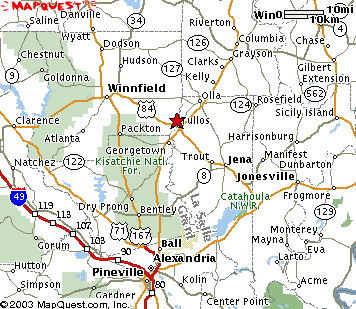 My main daydreaming subject is spots on the east, LaSalle Parish side of Little River a few miles south of the red star on this map. Little River is the boundary line between Grant Parish, west side, and LaSalle Parish, east side. I have semi-private access to over 3 miles of Little River.
My main daydreaming subject is spots on the east, LaSalle Parish side of Little River a few miles south of the red star on this map. Little River is the boundary line between Grant Parish, west side, and LaSalle Parish, east side. I have semi-private access to over 3 miles of Little River.  I retrieved my binoculars. When I walked back around the truck to the tailgate area, the moment I raised the binoculars off he flew, quickly disappearing from view. It was a puzzlement. Why didn't that hawk want me looking at it through binoculars? Then it struck me—he probably thought the binoculars were a gun.
I retrieved my binoculars. When I walked back around the truck to the tailgate area, the moment I raised the binoculars off he flew, quickly disappearing from view. It was a puzzlement. Why didn't that hawk want me looking at it through binoculars? Then it struck me—he probably thought the binoculars were a gun.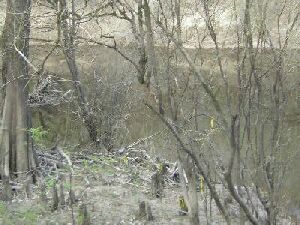
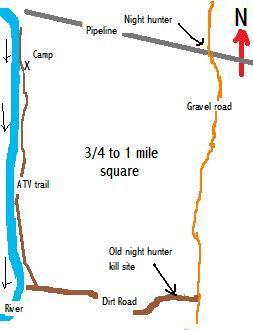 Concerned, I got up and walked down the dirt road until I could see my red night hunter warning light blinking, blinking, blinking. When I returned to the truck, I pulled
Concerned, I got up and walked down the dirt road until I could see my red night hunter warning light blinking, blinking, blinking. When I returned to the truck, I pulled 